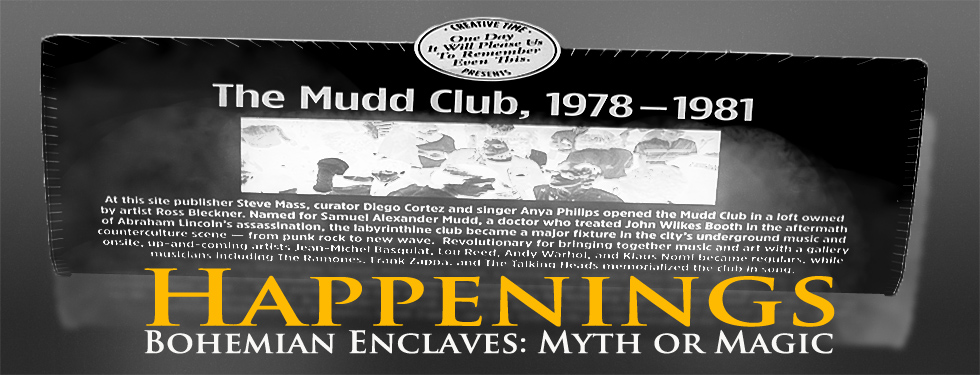Happenings
It's often said that part of the attraction of being an artist is the lifestyle. Some say art is less a career than it is a way of life.
I might posit that most professional careers require unique styles of life through necessity, inbreeding and reverance for the status quo, but these are tales for other days. For now, let's stick to artists who most agree are cut from different social canvas. Artists behave differently, think differently and tend to gravitate to one another for both work and play.
Or at least that's the decades-old myth. If once true, does it still apply, why or why not? Did those romanticized art and literary colonies of bohemian bliss ever really exist?
There's certainly enough written, video and image documentation to suggest that Montemartre and Monteparnasse were densely-concentrated artist colonies in early 20th century Paris. Artists made pilgrimmages from all corners of the planet -- from Siberia to the southern cone of the Americas and all points in between -- to participate in the fledgling modern movement.
Likewise, various neighborhoods throughout Manhattan including Chelsea, East Village, Brooklyn, Greenwich Village, SoHo and the lower east side all have well-documented histories as art colonies for Americans as well as European artists fleeing their war-torn nations.
London's art scene has historically not been as concentrated, but it has its own Soho and Cork Street gallery district in the west plus a widely dispersed art scene in Hoxton, Shoreditch, Bethnal Green, Hackney and other areas of east London. Not to mention the concentrations of art students around Goldsmiths art department in the south, and the more central Bloomsbury and Slade academic centers.
Most cities and university towns claim to have had an arts district during one phase or another. Gentrification of downtown cores frequently chased artists from one enclave to another to avoid bulldozers, high-priced condo developments and the invasion of designer-label shops. Artists move in, attract money, then are forced out due to their own success. Wash, rinse. repeat. Wynwood Arts District in downtown Miami is a current example of this chase.
Some local governments have tried various plans to recreate urban districts specifically for art-related business and dwellings, but artists tend to find their own corners based primarily on big cheap space and a few seedy pubs.
That was then and this is now. Many of UK artists' preferred watering holes have been overrun by scenesters. The Chelsea Hotel in NYC is being converted to condos. The Bloomsburys didn't last more than a generation. Max's Kansas City, the Algonquin, the Cedar Bar, the Mudd Club and many other NYC watering holes favored by the intellectual crowds of decades past are long gone. Chumley's? Closed, probably forever.
Not only did these exist, they created sparks of magic and madness that surviving participants will willingly attest.
What about today's hotpsots after decades of urban gentrification, suburban sprawl and instant global exposure through the internet made pilgrimage to a major art mecca less necessary?
How many artists still gather to participate in something grander than themselves?
Of those who do, does it help or hinder their progress?
More recently, some pockets of artists try to reach critical mass. Nothing seems to have been tightly defined as a few city blocks or a couple of key pubs as they once were in say, the SoHo lofts. Artists still tend to lean on each other, but it's more often around arts faculties. Is this good or bad? What about the co-ops? Are artist-run spaces a legitimate method to bypass the gallery gatekeepers? We'd like to explore the myths and the magic of artists flocking to share common ground.
We're not interested in the concentrations of galleries like Chelsea. That's a commercial necessity. Where are the artists living and working? Are they collaborating or just sharing cheap space with tall ceilings?
What experiences can you share? If you have interesting anecdotes or images that you would like to have considered for inclusion in this group article, please communicate with us through our Contact page.
